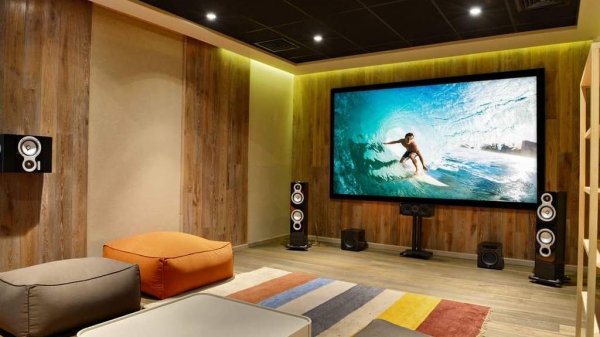Many cinema lovers and movie buffs go the extra mile to get the best possible home theatre electronics along with a huge library of Audio and Video content.
A well installed home cinema system can really add the extra oomph factor to your movie-watching experience. However, given the do-it-yourself nature of home theatre setups can be daunting for some users, especially those who have little experience with this. While you may do a great job installing your home cinema system yourself, there is always scope to improve it further.
At Ooberpad, we’re just like you; dangerously passionate about movies and binge-watching TV series for hours at a stretch. We feel there are certain useful aspects and ideas every home theatre enthusiast should know. If you are looking for a little more oomph from your movie sessions, here are some tips to bring that added punch to your home cinema setup.
Aim to use the same drivers/series
The best results in a home cinema system will be gained from using the same drivers or speakers from the same series, especially across the front three speakers. This will allow effects to transition from speaker to speaker in a much more convincing way. More than the size of the drivers, materials used in the driver and basic design play a huge role in tonal balance.
Aim to stay symmetrical
When you go to the movie cinema, usually you try and sit square to the screen with the speakers equal on either side. Many movie buffs go the extra mile to make it to the middle of the seating arrangement for the best results. The same principle goes for movie watching at home, the performance of your home theatre system will benefit too. Try to avoid putting your screen in a corner at all cost as this will affect speaker positions and subsequently the sound quality.
Speaker placement is paramount
When placing speakers for a home cinema system, the basic ‘rules’ that apply to placement in stereo apply here too. If your speakers have a rear-facing bass port, they will need a bit of room between the port and the rear wall. Avoid being very close to side walls as much as you can. If you are forced to cram the speaker into a corner, it is better to mount them on the wall instead.
Place your speakers at a similar height
For the best results, it is best to have the front, center, surround and rear channel speakers placed at the same height. While it may not always be possible for you to place the center speaker at the same height, aim to get it closest to the display source for better sound localization and perception. Apart from a great-sounding experience, speakers placed at the same height look aesthetically pleasing as well.
Experiment with your subwoofer placement
If you have only one place for the subwoofer that’s fine, however, if you do have some flexibility, it pays to experiment. Even smaller rooms can give very different results from the same subwoofer used in different locations. Getting the placement of a sub ‘right’ in the room can be just as good as an upgrade. One of the most consistently effective places is at the front, between your left or right speaker and the center.
Auto-calibration magic
We live in an age where clever setup and calibration software can make fine adjustments to the behavior of speakers wherever they’re placed. Although they’re handy tools to have, physically correcting some issues in the first place helps immensely. If none of your settings works, it is time to use auto-calibration. Most AVRs are equipped with a calibration mic and a DSP suite that uses an advanced algorithm to automatically correct speaker calibration depending on the room’s acoustics. Finally, it is advised to run a calibration test if you have moved/shifted the speakers around (physically).
The output of every home cinema system will vary depending on the room, the home theatre equipment, and your own preferences. However, if you stick to the basics, chances are you will have a system that is immersive and tailor-made to your needs. Isn’t that a great way to enjoy a movie?
We hope these tips help you get more out of your home cinema system. Do you have any more ideas or tips you can share? Make sure you share them in the comments section below!




